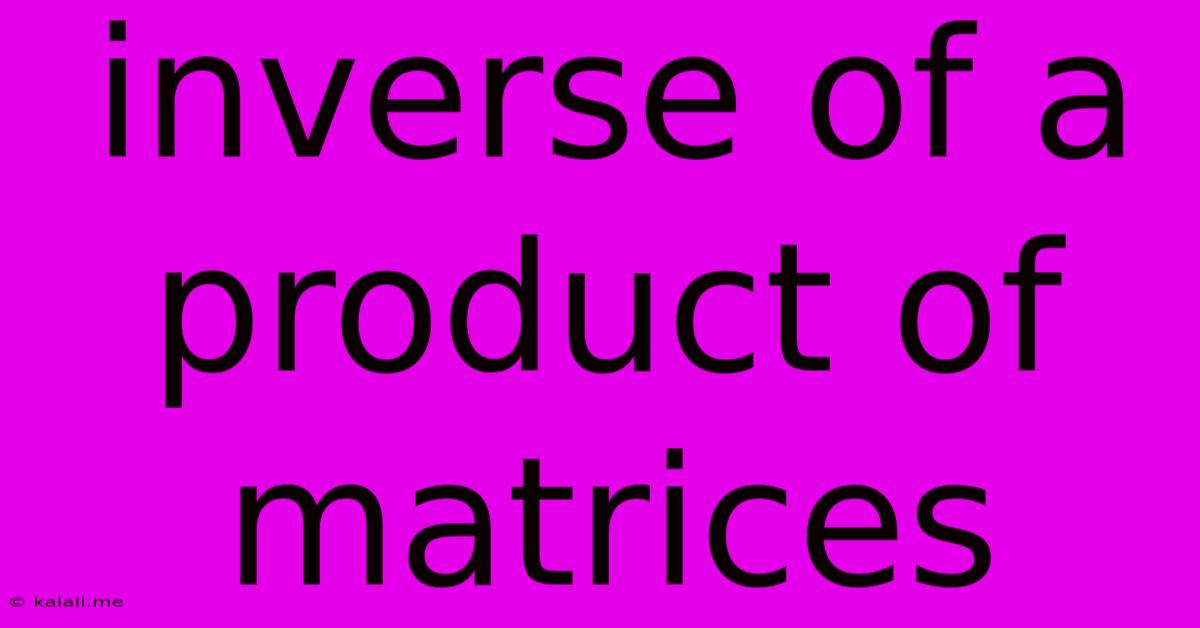Inverse Of A Product Of Matrices
Kalali
May 23, 2025 · 3 min read

Table of Contents
The Inverse of a Product of Matrices: A Comprehensive Guide
Finding the inverse of a matrix is a fundamental operation in linear algebra with applications spanning diverse fields like computer graphics, cryptography, and machine learning. This article delves into a crucial aspect of matrix inversion: determining the inverse of a product of matrices. Understanding this concept is vital for solving complex linear systems and manipulating matrix equations efficiently. This guide provides a clear explanation, practical examples, and explores the underlying mathematical principles.
Understanding Matrix Inverses
Before tackling the product of matrices, let's refresh our understanding of matrix inverses. A square matrix A has an inverse, denoted as A⁻¹, if and only if its determinant is non-zero (det(A) ≠ 0). The inverse satisfies the property: A A⁻¹ = A⁻¹ A = I, where I is the identity matrix. Finding the inverse often involves techniques like Gaussian elimination or using the adjugate matrix.
The Inverse of a Product: The Key Theorem
The core principle governing the inverse of a matrix product is this: The inverse of a product of invertible matrices is the product of their inverses in reverse order. Mathematically:
(ABC)⁻¹ = C⁻¹B⁻¹A⁻¹
This holds true for any number of invertible matrices. The reversal of the order is crucial and often a source of confusion for beginners. Let's break down why this is the case.
Proof and Intuition
We can prove this theorem by demonstrating that the product of the original matrix product and the reversed product of inverses yields the identity matrix.
Let's consider the product of three matrices, ABC. If we multiply this by C⁻¹B⁻¹A⁻¹, we get:
(ABC)(C⁻¹B⁻¹A⁻¹) = A(BC)(C⁻¹B⁻¹)A⁻¹ = A(B(CC⁻¹))(B⁻¹)A⁻¹ = A(BI)B⁻¹A⁻¹ = A(BB⁻¹)A⁻¹ = AIA⁻¹ = AA⁻¹ = I
This demonstrates that the reversed order of inverses is essential to achieve the identity matrix. The intuition behind this stems from the associativity of matrix multiplication and the fact that each inverse 'cancels out' its corresponding matrix in the original product.
Example: Calculating the Inverse of a Matrix Product
Let's illustrate this with a numerical example. Consider three matrices:
A = [[2, 0], [0, 1]]
B = [[1, 2], [3, 4]]
C = [[5, 0], [0, 2]]
First, calculate the individual inverses of A, B, and C:
A⁻¹ = [[1/2, 0], [0, 1]]
B⁻¹ = [[-2, 1], [3/2, -1/2]]
C⁻¹ = [[1/5, 0], [0, 1/2]]
Now, let's find the inverse of the product (ABC) using the theorem:
(ABC)⁻¹ = C⁻¹B⁻¹A⁻¹ = [[1/5, 0], [0, 1/2]] [[-2, 1], [3/2, -1/2]] [[1/2, 0], [0, 1]]
Performing the matrix multiplications, we obtain the inverse of (ABC). Note that directly calculating the product ABC and then finding its inverse would be significantly more computationally expensive.
Applications and Further Exploration
The ability to find the inverse of a matrix product is crucial in numerous applications. Solving systems of linear equations, particularly those represented in matrix form, relies heavily on matrix inversion. Furthermore, this concept is fundamental in understanding transformations in computer graphics and manipulating linear systems in various scientific and engineering domains. Exploring more advanced topics like block matrices and their inverses can further enhance your understanding of matrix operations.
This comprehensive guide provides a solid foundation for understanding the inverse of a product of matrices. Remember the key theorem and the crucial role of the reversed order of inverses for successful calculation and application in various fields.
Latest Posts
Latest Posts
-
How Many Eighths In A Quarter Pound
Jul 18, 2025
-
Can The Sine Of An Angle Ever Equal 2
Jul 18, 2025
-
How Many Months Is A Hundred Days
Jul 18, 2025
-
Mother And I Or Mother And Me
Jul 18, 2025
-
How Many Oz In One Water Bottle
Jul 18, 2025
Related Post
Thank you for visiting our website which covers about Inverse Of A Product Of Matrices . We hope the information provided has been useful to you. Feel free to contact us if you have any questions or need further assistance. See you next time and don't miss to bookmark.